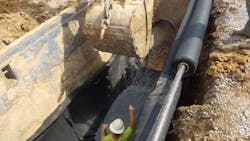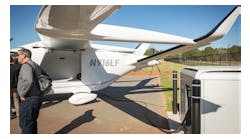When sinkholes began to develop along the outer edge of the safety area for the main runway at the Tuscaloosa Regional Airport (TCL), the city took action to save the airport, prevent damage to aircraft and protect the field maintenance crew by replacing the storm water drainage system. To stop future sinkholes due to infiltration of water into the system's Class III reinforced concrete pipe (RCP), the decision was made to use polypropylene pipe that has high-integrity gasketed joints between sections.
The Tuscaloosa Regional Airport is a general aviation airport with multiple fixed-based operator centers (FBO) serving some 60,000 charter, cargo, military and private aircraft operations each year as a vital economic engine for the city and the region. The new pipe was installed between the airport’s primary Runway 4-22 and the principal Parallel Taxiway A network that provides connectivity from the Runway 4-22 to the airport’s terminal area. Installation of new pipes was divided between two storm drainage collection systems between the runway and taxiway. The $1.08 million construction portion of the project was completed in late September after just 116 work days.
A significant portion of the storm drainage infrastructure dates to the late 1960s and the concrete pipe and joints along with the brick masonry inlet structures started showing signs of failure. Video inspection inside the lines showed that sediment was infiltrating through separation of some of the pipe joints and, to a greater degree, through failed mortar joints in the brick inlet structures along with the connection points from pipe to inlet structures. These failures, and the resulting sinkholes, provided the justification to rehabilitate the storm drainage system.
The project design was undertaken in the summer of 2016 by engineers in the Nashville office of Atkins, a member of the SNC Lavalin Group. Bids were taken in late summer of 2016, and the contract awarded to REV Construction Inc. Construction started in November 2016.
"The major elements of the work included 6,454 linear feet of storm drainage pipe that needed to be rehabilitated or replaced," said C. Darren Duckworth, P.E., project manager, aviation services for Atkins. "There were also 15 brick inlet structures that would be replaced with new precast concrete inlet structures along with installation of two replacement headwalls and grading of 372 linear feet of ditch channel.
"The existing pipe running under runways or taxiways was rehabilitated with Cured-In-Place Pipe (CIPP) linings so we wouldn’t have to dig up any of that pavement. Another 3,800 linear feet of pipe ended up being removed and replaced with new pipe. These pipes run under grassy areas that are not subject to traffic loading and lie outside of the Runway Safety Area (RSA) limits and any Taxiway Object Free Area (TOFA) limits. Bid options allowed for either removal and replacement with new pipe or rehab with CIPP linings, and the project specifications allowed for multiple options in the material to be used for pipe replacements. The successful bid from REV Construction elected to replace these pipe runs with a corrugated polypropylene pipe in accordance with FAA specification D-701."
The products that were submitted and approved included HP Storm pipe and SaniTite HP pipe, both from Advanced Drainage Systems Inc. More than 3,700 feet of HP polypropylene pipe was installed in diameters ranging from 24 to 48 inches in depths with up to 13 feet of cover.
The majority of the pipe was dual-wall pipe with a smooth inner wall and a corrugated outer wall. At the locations where the pipe connected into each inlet structure, however, a double-gasket connection was made from the main run of dual-walled HP Storm pipe to a section of triple-walled SaniTite HP pipe. The triple-walled pipe has a smooth exterior, which permits a better seal for the compression gasket at the inlet structure than would have been possible with the corrugated double-wall pipe exterior.
"The more usual practice in storm drain installations is to provide oversized openings in the precast structure and to subsequently complete the installation with an annular ring of non-shrink grout to fill the remaining void," explained Duckworth. "Grouted connections were specifically avoided to prevent the risk that any flexure or settlement of pipes might cause a grout failure that could ultimately create a potential point where sediment might be driven into the system with groundwater."
The contractor’s team worked through the material submittal process with ADS, the precast inlet structure supplier, and the design team to come up with a solution that would work.
Mandated in the contract was the requirement that contractor must provide a gasketed or booted watertight connection for all pipe openings. The solution was to use prefabricated compression gaskets of suitable size and performance range to match the outside diameter of the triple-wall polypropylene pipe at each inlet structure. These were supplied to the precast structure manufacturer and precast into the reinforced concrete inlet structures.
ADS HP Storm and SaniTite HP pipe are polypropylene (PP) pipes for gravity-flow drainage applications, providing pipe stiffness and premium joint performance. They use advanced polypropylene resin technology with a dual-wall and triple-wall profile design. Polypropylene pipe is approved by the Army Corps of Engineers for storm drainage applications under Section 33 40 00 (Unified Facilities Guide Specifications). The Federal Aviation Authority (FAA) permits polypropylene pipe under airfield pavements per Item D-701, Pipe for Storm Drains and Culverts in AC 150/5370-10G (Standards for Specifying Construction of Airports).
"The last thing we wanted to do was to spend more than a million dollars on this rehab effort and then have a joint fail, resulting in sediment getting into the pipe as it did before and creating sinkholes," Duckworth said.
"ln light of the sinkhole formations that propelled the need for this project, a major focus of the design was to specify watertight connections to reduce the opportunities for sediment to infiltrate into the rehabilitated system. As an additional measure of protection beyond the usual soil-tight gasket connecting the sections of ADS HP Storm pipe, we also specified double gaskets like those that would be used in a sanitary sewer application. This provided an additional measure of sealing beyond typical measures of soil- or silt-tightness to the 10.8 psi criteria for water-tightness corresponding to about 25 feet of head pressure."
"In addition to the pipe joints having double gaskets to guard against potential soil intrusion," explained Tori Durliat, director of marketing for ADS. "there are fewer joints in a corrugated polypropylene pipe line because of the 20-foot long sections — the old concrete pipes had a joint every four feet. In addition to providing fewer locations for a potential joint failure, the longer HP Storm pipe section length and lighter weight also allowed the installation to proceed more quickly. Most of the work was completed well in advance of the 140 day time limit specified in the contract."
The new system was designed for a five-year storm. "Typically, airfield infrastructure for storm drainage collection systems are required to meet only the five year storm," explained Duckworth. "The idea is that if it's raining so hard at an airport that it’s only likely to happen once every five years, you probably don't have a lot of people flying airplanes in those conditions.
"Generally speaking, the way an airport is designed, the pavement is elevated usually by more than a foot and a half or so from the areas where storm drainage collects. There are wide surrounding grassy areas with gentle slopes draining away from the pavement edges to provide the required positive drainage away from that runway. This all provides a lot of room for storm water to pond before it would get onto any pavements. If you do have a 10- or 25-year storm come across the airfield, it's only going to have an impact of a few hours of standing water before it would before it would make its way through the drainage system designed to carry the peak five-year storm flow.
"The economics just aren't there for designing and installing a system to handle a 10 or 25 year storm event that might occur, and if it does, then it's just a matter of waiting a few hours to let the five-year-storm-rated system do its job."
At Tuscaloosa, as it is at most airports, workspace is at a premium. The corridor between these areas used for staging, stockpiling, and equipment operations was just 57 feet wide.
"While working within a 57-foot corridor may not sound very restrictive, it was made slightly more difficult by the fact that the pipe alignment typically runs at an offset of just 10 to 12 feet from the edge of the Runway Safety Area," Duckworth commented. "In order to avoid any encroachment into the RSA, a trench box was employed, and excavated materials were stockpiled on the less-constrained taxiway side of the trench. Only removed sections of pipe were placed in the narrow space between the trench excavation and the edge of the RSA."
In addition to the RSA and TOFA boundaries, a third protected area impacting the site was the Runway Object Free Area (ROFA) that spans and crosses the pipelines between the runway and taxiway centerlines. Work was permitted in this area without requiring the closure of the runway. To comply with safety regulations, however, the pipe and other materials were frequently brought to the site from the contractor’s staging area in small enough quantities that stockpiles remained below the elevation of the adjacent pavements. This, along with assistance of the airport staff and the air traffic controllers in the tower, allowed the project to proceed without any operational impact from the project on Runway 4-22 or the Parallel Taxiway A system, which remained active throughout the construction process.
"The HP Storm pipe is easy to move because it is light and heavy equipment is not required," Durliat offered. "So taking sections from the staging area to the field and even moving those 20-foot sections around the field can be quickly accomplished with a minimum crew."
"The teamwork and cooperation among the project’s stakeholders," said Duckworth, including the Tuscaloosa Regional Airport, Atkins, REV Construction, and ADS, enabled the project to be completed on time and under budget, with relatively little impact to airport operations."
Steve Cooper has reported on a variety of storm water drainage and other pipeline projects for several decades. Based in New York, he has travelled extensively to conduct on-site news interviews with professional engineers, contractors, government officials and representatives of major companies supplying the industry. He can be reached at 516/623-7615 or [email protected].



